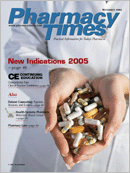Publication
Article
Pharmacy Times
Dealing with the Drug Interaction Skeptic
For Dr. Hansten, it was not hisbest moment as a pharmacist. Itwas the late 1960s, and he hadjust started his first job as a staff pharmacist/drug information specialist ata hospital in Berkeley, Calif. The drugorder that came down in the pneumatictube said, "Tetracycline 250 mgpo every 6 hours. Give 2 oz Maaloxwith each dose of tetracycline." Notmany drug interactions were well-documentedinthe 1960s, but thiswas certainly oneof them. Theyoung pharmacistcalled the physicianon the phoneand explained inhis most tactful manner that theantacid would reduce the bioavailabilityof the tetracycline to nearly zero.The physician was an older man, andhis response was something like,"Well sonny, I've been giving tetracyclinetogether with antacids for quitea while now, and I have not seen anyproblems. So, just fill the orders exactlythe way I wrote them." The physicianslammed the phone down beforethe pharmacist could respond, andthat was that.
Crestfallen that he had failed in hisvery first attempt to inform a physicianabout a drug interaction, theyoung pharmacist immediately soughtconsolation from his pharmacist colleagueswho were standing nearby.They knew what had happened, however,because they had previously triedto get this physician to change thesesame orders. With the wisdom thatcomes with experience, the colleaguespointed out that it might be betterthat the physician gives his tetracyclinewith antacids, because his use oftetracycline was almost always prophylacticin patients who did not reallyneed it.
The second author learned somethingimportant from that unpleasantexperience, however—namely, thatcasual clinical experience often is misleadingin the assessment of whether adrug interaction is potentially clinicallyimportant. Essentially, this physicianhad been using placebo tetracycline,but—because the patients didnot need the tetracyclinein the firstplace—he nevernoticed.
Prescribers' difficultyin correctlyidentifyingadverse drug interactionsin the clinical setting makeslife more difficult for pharmacists,because it can make the prescriberskeptical about the clinical importanceof many drug interactions. What pharmacist—upon informing a prescriberabout a drug interaction in one of hisor her patients—has not heard, "I usethat combination together all the time,and I don't see any problems"?
What are some of the factors thatpersuade clinicians to underestimate theclinical importance of drug interactions?
Interactions Involving Inhibition ofDrug Effect
As the tetracycline-antacid exampleshowed, inhibition of drug effect isoften overlooked. Even when thepatient truly needs the affected drug,reduced drug effect may be interpretedas simply normal variation in drugrequirements or worsening of the diseasestate requiring increased dose.Moreover, many drugs are given withoutany objective measure of drugresponse, and, in such cases, reduceddrug effects easily pass undetected.
Interactions with Rare AEs
Some drug interactions rarely causeserious adverse events (AEs), and thusthe individual clinician is unlikely toobserve the AE. For example, if a druginteraction causes a serious AE onlyonce in 1000 times that the combinationis given, one would have toobserve 3000 patients on the combinationto have a 95% chance of observingthe AE. Those odds presume thatthe clinician correctly identifies everyadverse interaction when it occurs—aclearly improbable assumption.
Interactions That Mimic NormalAdverse Drug Effects
When the manifestation of anadverse drug interaction is simply anextension of the pharmacodynamiceffect of the affected drug, an interactionmay be overlooked. For example,when a patient on a benzodiazepinebecomes excessively sedated due to adrug interaction, the effect may bewritten off as just a side effect and thedosage reduced.
Interactions in Complex Patients
In complex patients who have multiplediseases and many drugs beingstarted and stopped, it may be particularlydifficult to identify adverse druginteractions. For example, many drugs,diseases, and foods affect the internationalnormalized ratio (INR) inpatients on warfarin, and patients withacute illness—especially infections—can have wide swings in their INR.Sorting out the effect of drug interactionsin such patients is problematic.
Interactions Lost to Follow-up
Ambulatory patients who manifestadverse drug interactions may simplystop one or both medications on theirown without ever informing their prescriber.In such cases, the prescriberhas no chance of understanding whatwent wrong. Anyone who has elderlyrelatives knows that the more obstinateelderly are prone to making decisionsabout their drug therapy withoutinforming their health care provider.
Recommendations
- Make sure that you only call prescribersabout real drug interactions.Not all drug interactionalerts represent clinically importantdrug interactions, and prescribersmay be correct in beingskeptical because the drug interactionis bogus.
- Even when the drug interaction isreal, it is natural for prescribers tobe skeptical. Before discussing adrug interaction with prescribers,plan your response if you get the"I don't see it in my practice" line.
- Before discussing drug interactionswith prescribers, try to get a roughidea, if possible, of how often theinteraction produces AEs. If AEsfrom the interaction are indeedrare, prescribers may better understandwhy they have not seenthem.
- Be ready to offer managementoptions to prescribers. They arelikely to be more responsive if theysee a rational way to get around theinteraction and reduce the risk tothe patient.
Drs. Horn and Hansten are both professorsof pharmacy at the University of WashingtonSchool of Pharmacy. For an electronic versionof this article, including references ifany, visit www.hanstenandhorn.com.







